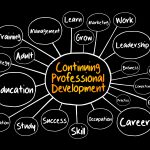Don’t Get Left Behind: Why It’s Critical to Engage in Professional Development
Within financial services, investors are demanding that the financial professionals with whom they work have the latest information at their fingertips and are up to date on all the latest tools and changes in the regulatory landscape. This means that financial professionals who don’t seek ongoing training and development are being left behind as their peers expand their skills and knowledge. They are likely to lose their edge and advancement opportunities in the process.
Quite simply, ongoing development keeps professionals relevant. Learning about new investment tools, regulations, strategies, and industry developments keeps them interested in the field and excited about their jobs. Without development, professionals tend to do what they’ve always done, which makes them out of step with industry advancements and unable to meet the demands of clients whether they be internal or external. Professional development can also boost a professional’s credibility, increase earning potential, and improve hiring prospects.
From an employer perspective, professional development is key to employee and client retention. In order for employees to rise to the challenge, their employers need to provide them appropriate ongoing training and development opportunities. By investing in their employees, companies show that they want to see them thrive in their current positions and are poising them for career growth. This improves morale, job satisfaction, productivity, and loyalty. Employees are more likely to stay with companies that invest in them, as it demonstrates that their employer values them and intends on a long-term relationship. Not only that, but bored, poorly trained, or unmotivated employees are a drain on employer productivity and lead to high turnover costs. Consider that Gallup research shows that the cost of replacing a single employee ranges from one-half to two times their salary. Not only that, but voluntary turnover can reduce team morale and damage client relationships. The good news is that research also shows that employers that offer professional development are better able to develop and retain talent. In fact, Gallup estimates that companies that rated highly on employee training saw 53% lower attrition.
Formal professional development can come in many forms – conferences, training, webinars, video series, and more – which means it’s highly accessible and caters to a wide range of schedules and availability. Conferences provide important networking opportunities, which can be exciting. However, conferences typically require more money, time, travel, and scheduling, which is why on-demand video training is so important. It is deep dive, quality education on the individual’s schedule from instructors who they may not otherwise be able to access.
Professional development is truly a mutually beneficial, “win-win” situation for employers and employees. Employees given the opportunity for regular development are more excited about their careers and confident in their skills and knowledge. They are more engaged and effective employees, and team leaders, which means clients are satisfied and employees working under them are also happier and more productive.
